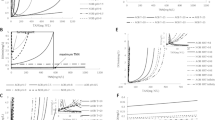Abstract
A shortcut biological nitrogen removal (SBNR) utilizes the concept of a direct conversion of ammonium to nitrite and then to nitrogen gas. A successful SBNR requires accumulation of nitrite in the system and inhibition of the activity of nitrite oxidizers. A high concentration of free ammonia (FA) inhibits nitrite oxidizers, but unfortunately decreases the ammonium removal rate as well. Therefore, the optimal range of FA concentration is necessary not only to stabilize nitrite accumulation but also to achieve maximum ammonium removal. In order to derive such optimal FA concentrations, the specific substrate utilization rates of ammonium and nitrite oxidizers were measured. The optimal FA concentration range appeared to be 5–10 mg/L for the adapted sludge. The simulated results from the modified inhibition model expressed by FA and ammonium/nitrite concentrations were shown very similar to the experimental results.






Similar content being viewed by others
References
Turk O, Mavinic DS (1989) Maintaining nitrite build-up in a system acclimated to free ammonia. Water Res 23:1383–1388
Abeling U, Seyfried CF (1992) Anaerobic-aerobic treatment of high strength ammonium wastewater nitrogen removal via nitrite. Water Sci Technol 26:1007–1015
Hellinga C, Schellen AAJC, Mulder JW, van Loosdrecht MCM, Heijnen JJ (1998) The SHARON process: an innovative method for nitrogen removal from ammonium-rich wastewater. Water Sci Technol 37:135–142
Chung J, Bae W, Lee YW, Ko GB, Lee SU, Park SJ (2004) Investigation of the effect of free ammonia concentration upon leachate treatment by shortcut biological nitrogen removal process. J Environ Sci Heal A 39:1655–1665
Turk O, Mavinic DS (1986) Preliminary assessment of a shortcut in nitrogen removal from wastewater. Can J Civ Eng 13:600–605
Turk O, Mavinic DS (1987) Selective inhibition: a novel concept for removing nitrogen from highly nitrogenous wastes. Environ Technol Lett 8:419–426
Chen SK, Juaw CK, Cheng SS (1991) Nitrification and denitrification of high-strength ammonium and nitrite wastewater with biofilm reactor. Water Sci Technol 23:1417–1425
Garrido JM, van Benthum WAJ, van Loosdrecht MCM, Heijnen JJ (1997) Influence of dissolved oxygen concentration on nitrite accumulation in a biofilm airlift suspension reactor. Biotechnol Bioeng 53:168–178
Bernet N, Dangcong P, Delganes JP, Moletta R (2001) Nitrification at low oxygen concentration in biofilm reactor. J Environ Eng 127:266–271
Anthonisen AC, Loehr RC, Prakasam TBS, Srinath EG (1976) Inhibition of nitrification by ammonia and nitrous acid. J Water Pollut Control Fed 48:835–852
Wong-Chong GM, Loehr RC (1978) Kinetics of microbial nitrification: nitrite-nitrogen oxidation. Water Res 12:605–609
Sauter LJ, Alleman JE (1980) A Streamlined approach to biological nitrogen removal. Environ Eng 296–306
Boon B, Laudelout H (1962) Kinetics of nitrite oxidation by Nitrobacter winogradskyi. Biochem J 85:440–447
Payne WJ (1981) Denitrification. Wiley, New York
Hanaki K, Wantawin C, Ohgaki S (1990) Nitrification at low levels of dissolved oxygen with and without organic loading in a suspended-growth reactor. Water Res 24:297–302
Villaverde S, Fernandez MT, Uruena MA, Fdz-Polanco F (1997) Influence of substrate concentration on the growth and activity of a nitrifying biofilm in a submerged biofilter. Environ Technol 18:921–928
Groeneweg J, Sellner B, Tappe W (1994) Ammonia oxidation in Nitrosomonas at NH3 concentrations near K m: effects of pH and temperature. Water Res 28:2561–2566
Murray RGE, Watson SW (1965) Structure of Nitrosocystis oceanus and composition with Nitrosomonas and Nitrobacter. J Bacteriol 189:1594–1609
Prakasam TBS, Loehr RC (1972) Microbial nitrification and denitrification in concentrated waste. Water Res 6:859–869
Wong-Chong GM, Loehr RC (1975) The kinetics of microbial nitrification. Water Res 9:1099–1106
Verstraete W, Vanstaen H, Voets JP (1977) Adaptation to nitrification of activated sludge systems treating highly nitrogenous water. J Water Pollut Control Fed 49:1604–1608
Alleman JE, Irvine RL (1980) Nitrification in the sequencing batch biological reactor. J Water Pollut Control Fed 52:2747–2754
Belser LW, Mays EL (1980) Specific inhibition of nitrite oxidation by chlorate and its use in assessing nitrification in soils and sediments. Appl Environ Microbiol 39:505–510
Hynes RK, Knowles R (1983) Inhibition of chemoautotrophic nitrification by sodium chlorate and sodium chlorite: a reexamination. Appl Environ Microbiol 45:1178–1182
Völsch A, Nader WF, Geiss GK, Sonntag HG, Birr C (1990) Test Zur Bestimmung der Aktivität von nitrifizierenden Bacterien in Belebtschlamm. GWF Wasser-Abwasser 131:301–306
Wood LB, Hurley BJ, Matthews PJ (1981) Some observations on the biochemistry and inhibition of nitrification. Water Res 15:543–551
American Public Health Association, American Water Works Association, Water Environment Federation (1998) Standard methods for the examination of water and wastewater, 20th edn. American Public Health Association, Washington DC
Park SJ (2004) Multi-species nitrifying biofilm model including substrate inhibition and oxygen limitation. PhD Dissertation, Hanyang University
Gee CS, Suidan MT, Pfeffer T (1990) Modelling of nitrification under substrate-inhibiting conditions. J Environ Eng 116:18–31
Gil KI, Choi ES (2001) Modelling of inhibition of nitrite oxidation in biological nitrification processes by free ammonia. Biotechnol Lett 23:2021–2026
Boon B, Laudelout H (1962) Kinetics of nitrite oxidation by Nitrobacter winogradsky. Biochem J 85:440–447
Bae W, Baek SC, Chung J, Lee YW (2002) Optimal operational factors for nitrite accumulation in batch reactors. Biodegradation 12:359–366
Acknowledgement
This work was supported by a grant (no. R01-2001-00437) from the Korea Science & Engineering Foundation (KOSEF).
Author information
Authors and Affiliations
Corresponding author
Rights and permissions
About this article
Cite this article
Chung, J., Shim, H., Park, SJ. et al. Optimization of free ammonia concentration for nitrite accumulation in shortcut biological nitrogen removal process. Bioprocess Biosyst Eng 28, 275–282 (2006). https://doi.org/10.1007/s00449-005-0035-y
Received:
Accepted:
Published:
Issue Date:
DOI: https://doi.org/10.1007/s00449-005-0035-y




